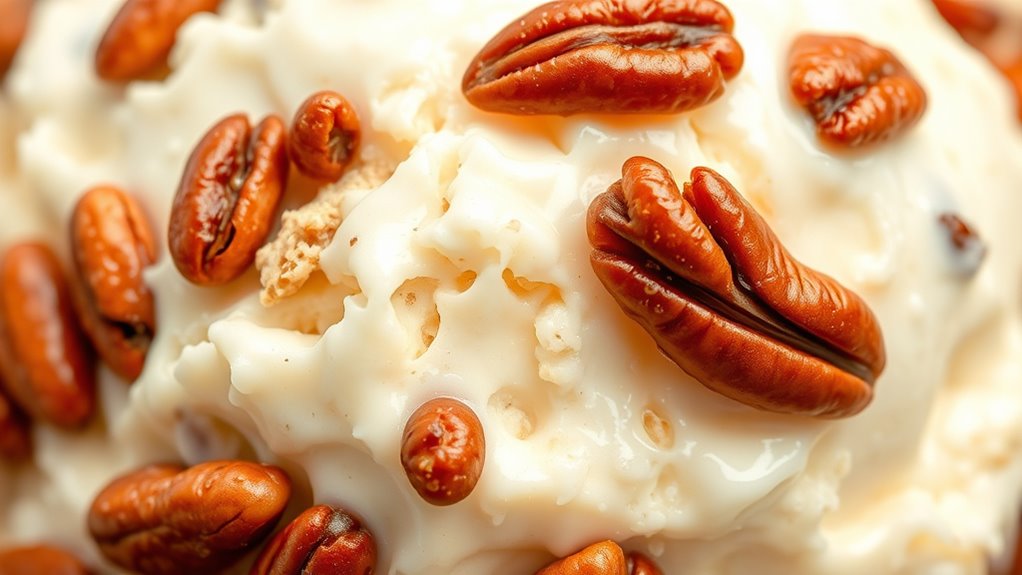To prevent oil migration and keep nuts crunchy in ice cream, you should pre-treat nuts with roasting or coatings to lock in oils and select varieties with lower oil content. Incorporate stabilizers, add nuts near the end of churning, and use quick freezing methods to preserve texture. Proper storage and packaging are essential for maintaining quality over time. Continue exploring for detailed techniques to optimize nut texture and flavor in your ice cream.
Key Takeaways
- Pre-treat nuts with roasting or stabilizers to minimize oil migration and maintain crunch.
- Add nuts near the end of churning to preserve firmness and prevent sogginess.
- Use quick freezing techniques to lock in nut texture and prevent oil seepage during storage.
- Select nuts with lower oil content and properly dry them before incorporation for better stability.
- Store ice cream at consistent, cold temperatures to reduce oil separation and preserve nut crunch.

Nuts in ice cream add a delightful crunch and rich flavor that can elevate any scoop. When you bite into a scoop topped with chopped almonds, pecans, or walnuts, you’re experiencing a perfect blend of creamy sweetness and hearty texture. However, to keep that crunch and flavor intact throughout the ice cream’s shelf life, you need to understand the challenges of nut oil separation and nut texture preservation. These issues directly influence the quality and enjoyment of your favorite frozen treat.
Nut oil separation occurs when the oils within the nuts migrate out of their cell structures and seep into the surrounding ice cream matrix. This migration can cause the nuts to become soggy or greasy over time, diminishing their crunch and altering the flavor profile. To prevent this, it’s vital to incorporate techniques that minimize oil migration. For example, pre-treating nuts with techniques like roasting or coating them with stabilizers can help lock in their oils, making them less prone to separation. Additionally, choosing nuts with lower oil content or those that are properly dried and stored can make a significant difference in maintaining their integrity within the ice cream.
Nut oil separation causes soggy nuts; roasting and stabilizers help lock in oils and preserve crunch.
Preserving nut texture is equally important. When nuts are added to ice cream, their texture can deteriorate if not handled properly. Exposure to moisture and low temperatures can cause nuts to become soft or develop undesirable textures, leading to a less satisfying crunch. To combat this, it’s best to add nuts at the right stage during the ice cream churning process—preferably towards the end—to ensure they retain their firmness. Using techniques like quick freezing or flash freezing nuts before mixing them into the ice cream can also help preserve their original texture. Additionally, selecting nuts that are freshly toasted or roasted can enhance their crunch and flavor, making them more resilient to the freezing process.
It’s also worth noting that the type of nut and how it’s prepared play a role in how well it holds up in ice cream. For instance, roasted almonds tend to maintain their crunch longer than raw nuts, especially if you take steps to coat or stabilize them. Proper packaging and storage of the finished ice cream are also critical. Keeping the product at a consistent, cold temperature prevents temperature fluctuations that could cause oil separation and texture loss. Moreover, understanding the oil content of different nuts can help in selecting those that are less prone to becoming greasy, thus maintaining their crunch and flavor for a longer period.
Frequently Asked Questions
How Do Different Nut Types Affect Ice Cream Shelf Life?
Different nut types markedly impact ice cream shelf stability. For instance, higher oil content in nuts like walnuts can lead to faster oil migration, reducing crunch and freshness over time. Conversely, nuts with lower oil levels, such as almonds, help maintain texture longer. You should consider nut type carefully when formulating ice cream, as it directly influences shelf life and overall quality, ensuring your product stays delicious and crunchy longer.
Can Nut Oils Cause Ice Cream Spoilage Over Time?
Ironically, your nut oils might be secretly plotting spoilage. Over time, nut oil oxidation can cause off-flavors, turning your ice cream into a flavor transfer nightmare. While it doesn’t spoil in the traditional sense, oxidized oils can compromise texture and taste, making you question that perfect scoop. Keep nuts well-sealed and store ice cream properly to slow oxidation, preserving crunch and preventing unwanted flavor swaps.
What Are Best Practices for Storing Nut-Infused Ice Cream?
To guarantee ideal storage of nut-infused ice cream, keep it in a tightly sealed container to prevent moisture and odor transfer. Maintain a consistent, cold temperature in your freezer, ideally around -20°C (-4°F), to preserve nut freshness and prevent oil migration. Avoid frequent temperature fluctuations, and store the ice cream away from strong-smelling foods. These practices help retain crunch and prevent spoilage, keeping your nut-infused ice cream delicious longer.
How Does Nut Particle Size Influence Crunch Retention?
Smaller nut particles improve crunch retention because they disperse more evenly throughout your ice cream, enhancing texture. Their increased surface area effects help maintain crunch longer, as they resist oil migration better than larger particles. To maximize this, choose finely chopped nuts for your mix. This ensures a consistent crunch experience, with better particle dispersion and sustained texture, keeping your ice cream deliciously crunchy and satisfying every time you serve it.
Are There Health Concerns With Nut Oil Migration in Ice Cream?
You might worry about nut oil migration affecting health, but it’s generally safe unless you have a nut allergy. Oil oxidation can cause off-flavors, but it doesn’t usually pose significant health risks. If you’re sensitive or allergic, avoid ice cream with nut oils, as even tiny amounts can trigger reactions. For most, oil migration doesn’t threaten safety, but always check labels for allergen info and fresh ingredients.
Conclusion
As you enjoy your ice cream with nuts, remember the delicate balance between crunch and cream. Oil migration threatens that crunch, turning textures soft and flavors muted. Yet, with proper handling, you can preserve that satisfying snap, that joyful contrast. It’s a dance between preservation and indulgence, where each bite marries richness with crispness. So savor every spoonful, knowing that with care, your treat will remain the perfect harmony of smooth ice cream and crunchy nuts.










